The Bucks and Blood of Singing Falls
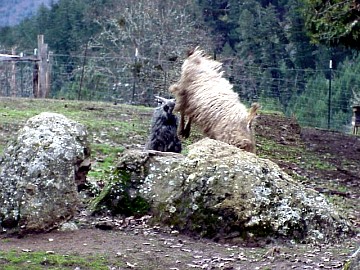
The Bucking Bucks'Unabashed Bashing Binge
There is an old adage found among shepherds. The saying goes, "Your buck is half your herd." At first glance such a statement seems quite politically incorrect in our fast paced western culture. However, sound reasoning attends the principle that formulated this proverb from ancient times. Open range breeding practices dictate that the dominant male of the herd bred as many does as he could. He stopped only when he was so completely exhausted mating and battling that the next male in the line of authority in the herd went "relatively" unchallenged. As the breeding season progressed, the genetics of the herd were progressively less impacted by the weaker and younger males.
It is a general practice to use one buck to service a dozen or more does in a given breeding season. Therefore, his genetics will appear in many offspring when spring arrives with a vengeance. A doe, on the other hand, will only affect one or two offspring in a given year. Hence, the origins of the ancient proverb above quoted.
Human intervention in this 'survival of the fittest' activity of the herd has dramatically influenced the genetic characteristics of domestic livestock. Contemporary breeding practices orchestrate the nuances of the characteristics of the herd by pairing up and choosing on the basis of a multitude of elements being watched for in the breeding program. Fineness of fleece or brilliance of color may not be possessed by a dominant buck of the herd, and so another buck is placed with a group of does. The avoidance of inbreeding is another compelling reason for deciding which buck goes with which group of does. Studies have shown that "breeding back" to near relatives to try and capture a fantastic trait that may have surfaced in a blood line is a very dangerous practice. Body frame and bone size, resistance to disease and parasites, and vigor on an average can diminish 25% in one inbreeding. When one 'back breeds', they gamble. They may succeed in capturing a fine trait but they also amplify the chances of a weakness. Often times a hidden genetic fault will come to the surface. The broad and widely known weaknesses in dog breeds illustrates the principle of which we speak.
Here at Singing Falls we do not practice what is known as line-breeding. We keep our blood lines at a healthy distance, which often times means we have a rather broad selection of bucks at the place. The varied gene pool best serves our goals of a naturally healthy and strong herd without compromising fleece quality. The truth is that we have attempted to bring in a new buck (and therefore, new blood) every year. In some cases we keep a bloodline going and a proven buck's son eventually takes over where his sire left off. Such was the case with one of our best bucks (bred by Isa Jennings, Oregon Colored Angoras). He was our herd sire, Willow (see below.) His son Tom Bombadil now reigns in his stead. The bloodline continues.
Pictures say a thousand words and that is so true when viewing the regal majesty of an angora goat herd sire. Below is a display of images: current bucks and a few individuals who have graced our herd in the past and have impacted our breeding program. These guys are a blessing and a cursing all at once. Most of the year they are as mellow as can be, grazing contentedly with one another, not looking for a fight. But the greater portion of what makes the paddock areas look like a world class war zone with fences needing constant mending is directly related to the antics of the autumn rite of the "rut".
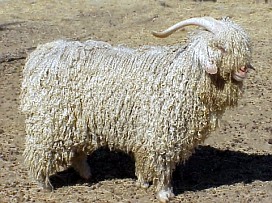
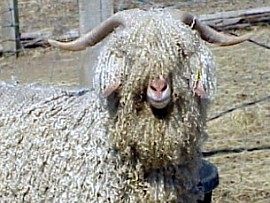
Here we have Roz, Reserve Grand Champion in a recent fiber show (Black Sheep Gathering.) He heralds from Sandra Erpelding's farm. Roz is a registered white angora buck. Alexandra loves his long, silky locks which separate readily into splendid doll hair locks. Those curly bangs must be snipped once in awhile or that tendency called 'snow blindness' sets in and poor Roz won't be able to see where he is going! Alexandra loves heavy face coverage on her goats (whereas Stan opts for a more open-faced goat.) Over the years Alexandra has mostly gotten her way in the matter.
TOP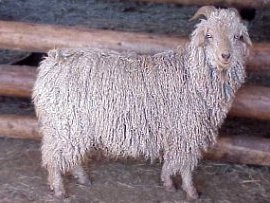
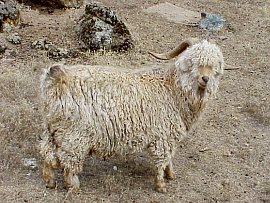
'Tom Bombadil' also known as Bombadillo is a son of Willow. As time fast forwarded, it became known to us that this boy was a keeper. The first photo shows him as a yearling. He is colored much as his sire was (a light red coloration.) Like many of the 'red' angora goats, he was born with a very dark brown fleece. His fine fleece faded with time and is now a light red. He possesses the same soft,fine fleece and unique dense coverage that his sire possessed. The kids that he sired this year (2007) were incredible for color and fleece. We are pleased with Bombadillo.
TOP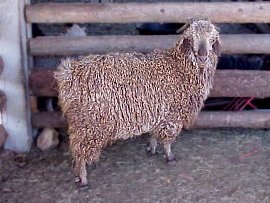
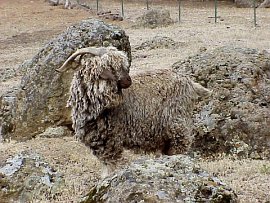
Aretz happens to be the darkest brown buck we have ever used and he produces color on a regular basis. We've utilized his services for two years running now. In 2007 he produced a lot of dark brown color in the kids. His kids always have a uniform fleece from front to back, something we strive for. On occasion we hit the 'jackpot' with one of his kids and a dark brown, full fleeced kid is ushered forth. This past year we were surprised and happy to see he can throw black. One of his kid daughters (Lila) born in 2007 is as black as a lump of coal. Aretz is out of the dark brown buck Dallas (Ferncrest Farms) To the left: Aretz as a yearling. To the right: Aretz as a mature buck.
TOP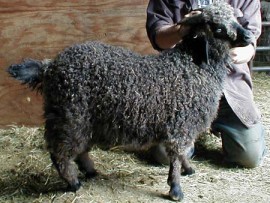
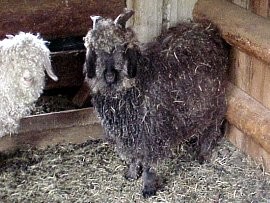
Otis came to Singing Falls as a young and promising buck from Ferncrest Farms. His fleece is fine (inherited from his sire) and black. He is what is known as a 'dominant black,' a color we have been seeking for some time in our search for a breeding buck. One day Stan Sours wrote a brief note saying that Otis was available. He sent a picture or two. Alexandra looked at Otis' pedigree and said, 'yes, he belongs here!' We are excited about the kids that will be produced now that Otis has arrived.
TOP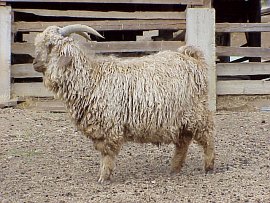
Theoden is a yearling buck that we see a lot of potential in. He is an Aretz son. Aretz, dark brown, bred B-1, the darkest cinnamon red doe we have. Somehow all the 'good traits' we have wanted to see in a buck popped out when Theoden was born. His fleece is extremely fine, dark in coloration and superb in regard to lock type. He will no doubt be 'tried' as a breeder in autumn 2007. Whether some of the bigger does will accept him or not remains to be seen. (They prefer the 'big guys.')
TOP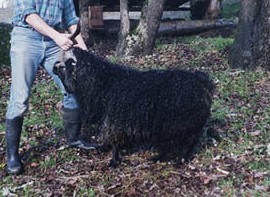
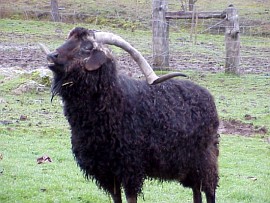
Bucks from the Past: Here's "Zebby" (Zebulun). This photo was taken right after we purchased him, when he was yet a little tyke. As a fully matured adult he sported a very large horn span and a coarser fleece. He was king of the herd for a long time and all the does swooned over him. Over time he was replaced by younger bucks with denser and finer fleeces, but Stanley always sensed a deep benefit in his gene pool. Zeb was from Coon Hollow breeding and was the first colored buck we brought to this farm when he was just a youngster and we (Stanley and Alexandra) were much younger also, that being 12 or more years back! To this day Stanley thinks highly of the good bloodline represented by Zebulun. His genes are still a very strong inprint throughout the herd
Manassah (Oregon Colored Angoras) was his sire, and was a light red goat born from registered parents. People in the goat business recall Manassah's good fleece qualities and lineage.
TOP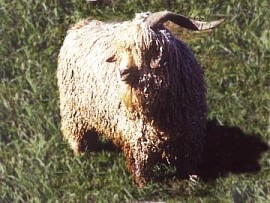
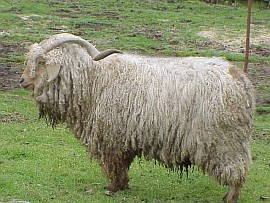
Willow, a handsome red buck of Oregon Colored Angoras (Jennings') breeding. We could not have been more pleased with him as a breeder. The great Willow has since passed on, but his progeny remain here. He has one son (Tom Bombadil) along with approximately eight or nine very nice daughters that we have kept for their impressive body structures, horn structures and fleece qualities. We now have quite a collection of Willow granddaughters also! Willow was a fine specimen of angora goat type (notice the high density coverage on him as well as the crimp in his mohair.) What an outstanding boy! We miss his presence even today, but are so glad we kept his bloodline strong in our herd.
TOP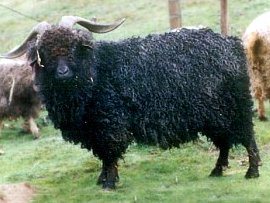
Silverado was one of the earliest bucks we used here and his bloodline still influences some of the herd. He was David and Julie Mahoney's Kiddoebuck herd sire for many years in the early days of colored angora goat beginnings. He hailed from Texas and it was told that he was born from a purebred white herd. We are grateful to the Mahoneys for the use of Silverado and eventually, many of his progeny.
TOP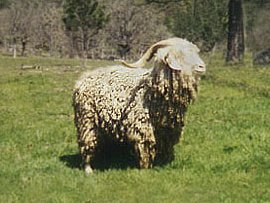
This is "Scion" a pure bred registered white Angora buck. At the age of six years, his fleece micron count compared to many yearling fleeces. He also has gone to goat heaven since these photos were taken, but we have his daughters and granddaughters to carry on his tradition. We used his fleece mainly for providing our doll makers and fiber crafters with high quality long staple fiber with a lot of character.
TOP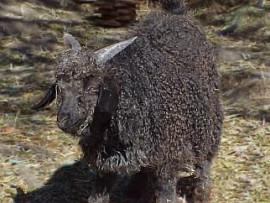
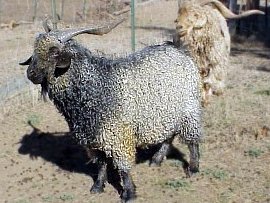
Ace of Spades ('Spade') was a favorite of Alexandra and was babied by her until he became a big boy and needed no more babying! Spade was from the recessive black gene pool, a son of Coon Hollow's Baraq. See beautiful Baraq below.
TOP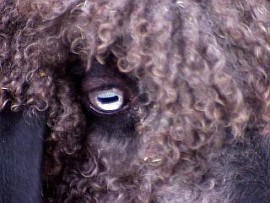
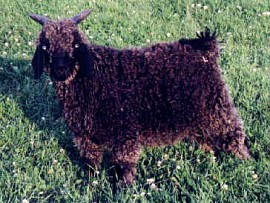
Baraq was with us for a little more than a year and actually sired a few kids. He was a gorgeous buck from the recessive black gene pool. His mohair fiber was exquisite. Alexandra's favorite sweater was knit from a yarn she hand spun from his first clip fleece. One woeful September day, dry with drought, we experienced a cloudburst of rain. The goats happened to be out at that time. Lightning was striking all around. Alexandra ran to bring all the goats into the barn. Drenched to the bone but happy because the much-needed water was flowing like rivers from the sky, she entered the house, satisfied the goats were all safe and secure in their barn. The next morning Stan found his body outside the barn. Somehow Baraq had not followed the others as quickly and was left outside. Struck by lightning? We always wondered. We mourned for a long time after losing him. On the left, his blue eye looking out through black kid hair. On the right, Baraq as a kid.
TOP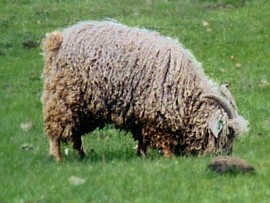
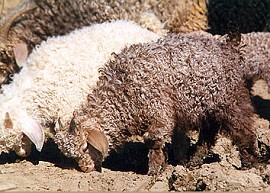
Dakota was a buck of small stature from Kiddoebuck fame. He was the first 'dark brown' fleeced goat we had ever seen and we used him extensively over the years in our breeding program. Some of his progeny were large. Others, especially his daughters, remained smaller in stature. One thing we were assured of: all his progeny sported gorgeous fleeces and most were dark in color. His blood remains in the herd today.
TOP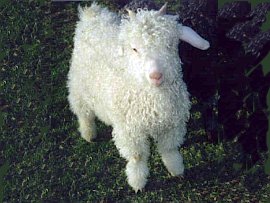

Rocky was another registered white buck that impacted our herd. Diane Coon always did a great job 'finding' fine hand spinning fleeces on registered animals. This buck was another 'find' of Diane's. We inherited him from a friend, Cis Hansen, who was phasing out of angora goats at the time.
TOPSinging Falls Herd
Does of the Umpqua Goat Band
Kids of Many Colors
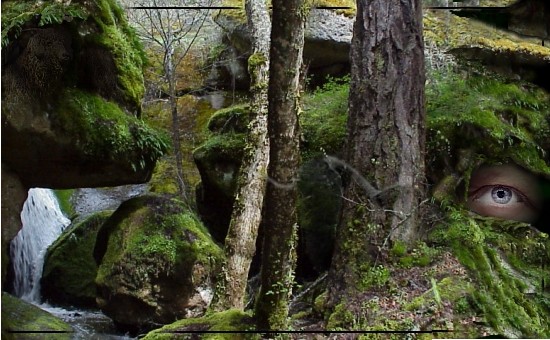
![[the singing falls waterfall]](images/alpha/singing_falls.gif)
![[singing falls logo text]](images/alpha/singingfalls_headmast.jpg)
![Capella the shepherd star with the kids, Hoedus I, Hoedus II and Al Anz [capella, the goat shepherd's constellation]](images/alpha/capella.gif)



